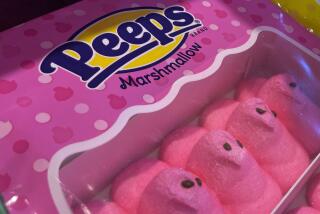Ban on Grapes With Sulfites Lifted
- Share via
In a ruling that appeared to displease both consumer groups and growers, the Environmental Protection Agency on Thursday lifted a ban on the sale of table grapes with sulfite residues in excess of 10 parts per million or more but said the fruit must be identified with stem tags or posted warning signs at produce counters.
The preservative, which maintains the fruit’s color and texture during extended storage, can cause severe allergic reactions in asthmatics and other individuals sensitive to the compound. Symptoms include headache, skin rashes, nausea and breathing difficulties.
The chemical has also been linked to as many as 13 deaths, according to a federal estimate. More than 1 million Americans are believed to be susceptible to sulfites.
A Never-Tested Policy
The EPA’s ruling revised a never-tested policy that went into effect after last year’s harvest and banned the sale of grapes whose sulfur dioxide residues reached 10 p.p.m. Rick Tinsworth, the EPA’s director of pesticide registration, said California growers complained that it would be a “logistical and cost nightmare” to meet that standard this season.
Under the new rule, if grapes exceed 10 p.p.m. of sulfites, 40% of all grape clusters in any shipment must be tagged or stores must display a placard at the produce counter indicating the chemical’s presence, the EPA said.
The tags and signs must state: “These grapes are treated with sulfites.” Growers have the option of including language that indicates the chemical was used to ensure freshness or quality.
The FDA banned the use of sulfites on fresh fruits and vegetables in 1986. The chemical’s presence in processed food and beverages must also be disclosed on labels.
The new ruling, which takes effect next week, was sharply criticized on several fronts.
Action Termed ‘Ridiculous’
The Center for Science in the Public Interest, a Washington-based consumer group, labeled the action “ridiculous.” A Center for Science spokesman said the move is a concession to the $1-billion California table grape industry and will ultimately confuse consumers.
“We strongly oppose any effort to do away with the certification program (which prevents grapes exceeding the 10-p.p.m. limit from coming to market),” said Mitch Zeller, the center’s assistant director for legal affairs. “This is an accident waiting to happen.”
The action has also disappointed food retailers who believe that the EPA should require growers to keep detectable levels of sulfites below the 10-p.p.m. level.
“The EPA should enforce the law (which bans use of sulfites on fresh fruits),” said Karen Brown of the Food Marketing Institute, a Washington-based grocers’ group. “And we don’t think that placards in the stores or bunch-labeling are adequate ways to alert consumers. I would question this kind of merchandising.”
Hardship Seen
And a growers’ group contended that the imposition of the regulation, in the middle of the state’s grape harvest, is unfair and arbitrary. Bruce Obbink, the California Table Grape Commission president, said the regulation creates a hardship for his members but that the industry will comply. He maintained that sulfur dioxide should not be classified as a sulfiting agent.
“We have been using sulfur dioxide for 60 years and never in the history of the industry has anyone reported getting ill from eating a grape treated with (that chemical),” he said.
The industry, 90% of which is based in the San Joaquin Valley, is in the process of adopting a stem-labeling program that will cost $9 million this season alone, Obbink said.
Traditionally, either the Food and Drug Administration or the U.S. Department of Agriculture establishes food-related regulations. However, in this case, the chemical is applied to grapes during cold storage to prevent mold or fungus from forming and, as such, falls into the EPA’s jurisdiction. In fact, some grapes remain in storage for as long as five months and are sprayed with a sulfur dioxide gas once every seven to 10 days.
More to Read
Inside the business of entertainment
The Wide Shot brings you news, analysis and insights on everything from streaming wars to production — and what it all means for the future.
You may occasionally receive promotional content from the Los Angeles Times.










